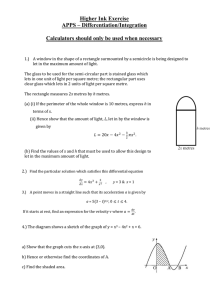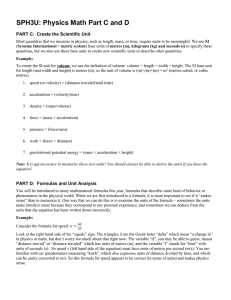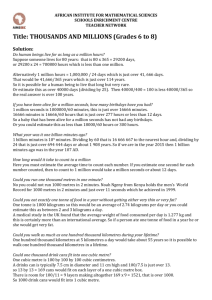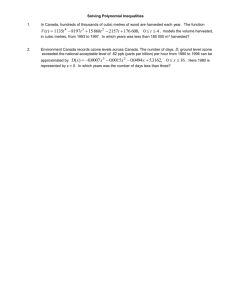Basic numerical skills: MEASUREMENT, SCALES AND UNITS 2
advertisement
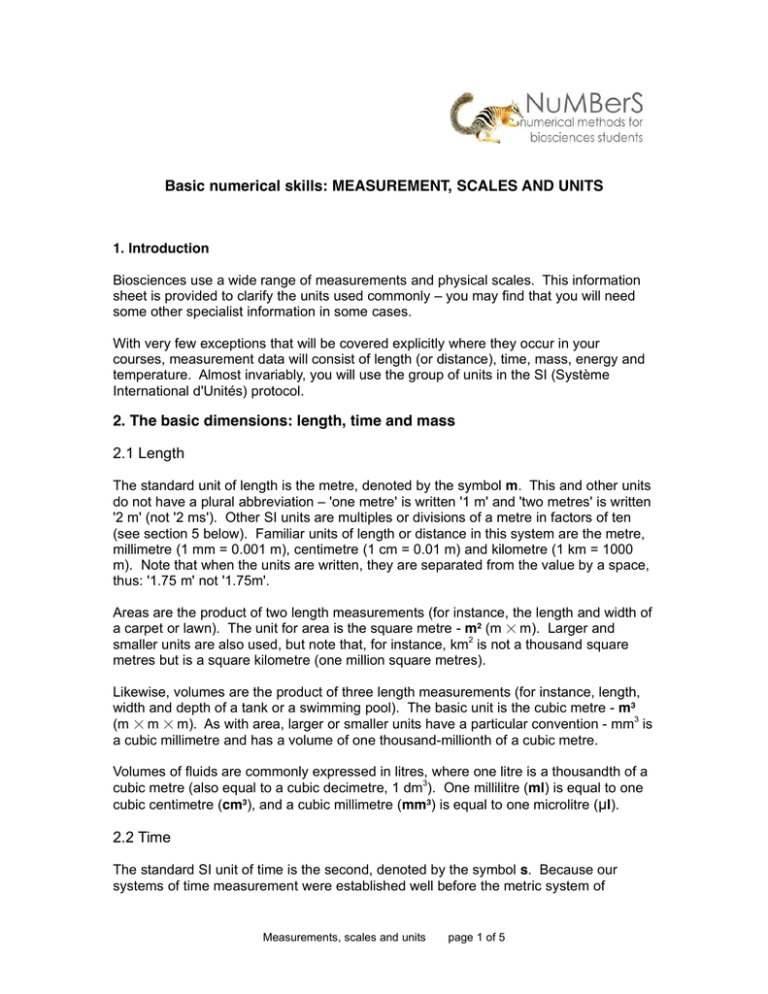
Basic numerical skills: MEASUREMENT, SCALES AND UNITS 1. Introduction Biosciences use a wide range of measurements and physical scales. This information sheet is provided to clarify the units used commonly – you may find that you will need some other specialist information in some cases. With very few exceptions that will be covered explicitly where they occur in your courses, measurement data will consist of length (or distance), time, mass, energy and temperature. Almost invariably, you will use the group of units in the SI (Système International d'Unités) protocol. 2. The basic dimensions: length, time and mass 2.1 Length The standard unit of length is the metre, denoted by the symbol m. This and other units do not have a plural abbreviation – 'one metre' is written '1 m' and 'two metres' is written '2 m' (not '2 ms'). Other SI units are multiples or divisions of a metre in factors of ten (see section 5 below). Familiar units of length or distance in this system are the metre, millimetre (1 mm = 0.001 m), centimetre (1 cm = 0.01 m) and kilometre (1 km = 1000 m). Note that when the units are written, they are separated from the value by a space, thus: '1.75 m' not '1.75m'. Areas are the product of two length measurements (for instance, the length and width of a carpet or lawn). The unit for area is the square metre - m2 (m ܈m). Larger and smaller units are also used, but note that, for instance, km2 is not a thousand square metres but is a square kilometre (one million square metres). Likewise, volumes are the product of three length measurements (for instance, length, width and depth of a tank or a swimming pool). The basic unit is the cubic metre - m3 (m ܈m ܈m). As with area, larger or smaller units have a particular convention - mm3 is a cubic millimetre and has a volume of one thousand-millionth of a cubic metre. Volumes of fluids are commonly expressed in litres, where one litre is a thousandth of a cubic metre (also equal to a cubic decimetre, 1 dm3). One millilitre (ml) is equal to one cubic centimetre (cm3), and a cubic millimetre (mm3) is equal to one microlitre (µl). 2.2 Time The standard SI unit of time is the second, denoted by the symbol s. Because our systems of time measurement were established well before the metric system of Measurements, scales and units page 1 of 5 measurement, and because the second is quite a small unit for common use, we continue to use non-SI units for time in biosciences, such as minutes (1 min = 60 s), hours (1 h = 3600 s), days (1 d = 86 400 s) and years (1 y ∼ 31 557 600 s). Measurements of quantities such as speed, the rate of change of distance with time, are expressed as being 'per second' or 'per hour'. The SI adopts a special notation for this for instance a speed of five metres per second would be written as '5 m s-1', where the 'm s-1' means 'number of metres divided by number of seconds' (see section 4 below). Some older texts may use the format 'm/s' to indicate metres per second, but this should no longer be used. Where regular events take place, such as the vibration of a violin string or of a tuning fork, the rate of these events is expressed as a frequency. The number of events per second is given the unit of Hertz (Hz), where 1 Hz is one vibration or cycle per second (that is 1 Hz = 1 s-1). We encounter this unit in everyday life in describing sounds and radio waves, where units such as kilohertz (kHz) and megahertz (MHz) are used, and in the clock speeds of computer processors expressed in gigahertz (GHz). Measurement of radioactivity, as the rate of nuclear disintegrations, is also expressed using a time-based unit. The Bequerel (symbol Bq) is one nuclear disintegration per second, so that 1 Bq = 1 s-1. A decay rate of 1 Bq is so low as to be practically immeasurable, so that you are more likely to encounter the units kilobequerels (1 kBq = 1000 Bq) or megabequerels (1 MBq = 1 000 000 Bq). You may encounter an older nonSI unit, the curie, where 1 Ci = 37 GBq. Because different radioisotopes differ in the type and energy of their emissions, the Bequerel is not a consistent measure of energy intensity or exposure. 2.3 Mass Mass is the measure of the amount of material in an object. It is measured in grammes, denoted by the symbol g. Everyday units of mass are grammes, kilogrammes, and tonnes (1 tonne = 1000 kg). You will also see the smaller unit of milligrammes used in medicines and other pharmaceuticals. The masses of atoms and molecules are often expressed in terms of a notional standard atomic mass unit, usually written in biochemistry and molecular biology as a dalton (Da). A dalton is one twelfth of the mass of an atom of the carbon-12 isotope (12C), and is a relative unit rather than being an absolute mass. Large molecules such as proteins typically have masses expressed in kilodaltons (kDa = 1000 Da). Another relative unit is used in biological- and environmental- chemistry. The 'mole' is the amount of the element or compound that contains a specified number of atoms. The number is called Avagadro's number, and is very large indeed! The resultant unit, written mol, is useful because it indicates the amount of an element or compound that can combine with another element or compound. The formation of 1 mol of hydrogen chloride (about 36.5 g) results from the combination of 1 mol of chlorine (about 35.5 g) with 1 mol of hydrogen (about 1 g). We commonly think of mass and weight as interchangeable terms for the same thing. However, weight is a force, that is a product of mass and the gravitational attraction between objects. An object with a mass of 1 g will always have a mass of 1 g. On the Measurements, scales and units page 2 of 5 surface of the Earth, it will have exert a 'downwards' force that we describe as a 'weight of 1 gramme', whereas on the surface of the Moon that force would be equivalent to a 'weight of 0.16 gramme' on Earth. More properly, the weight should be expressed in units of force, where force is mass times acceleration, denoted as Newtons (N). The quantity usually called 'density' (occasionally 'specific gravity') is the mass of an object divided by the volume that it occupies. The units for density are mass per unit volume, for example kg m-3 (see section 4 below). In everyday speech, we sometimes erroneously describe materials as 'heavy' when we intend to say that they have high density. 3. Energy and temperature 3.1 Energy Energy is found in Nature in many different forms, A basic definition of energy is 'the capacity to do work', and the different forms of energy can often be converted from one to another. The SI unit of energy is the Joule (J). Like the Newton and Hertz, this unit is named after a famous scientist. In everyday life, you are more likely to meet another, non-SI unit of energy, the calorie (cal). Food labelling shows the energy content of different foodstuffs, usually in units of kcal (1000 cal). One calorie is just over 4 Joules, and is equivalent to the heat energy needed to raise the temperature of 1 gramme of water by 1°C. So both the Joule and calorie are quite small units. In biosciences you will meet not only measurements of the quantity of energy, but also the rate at which energy is transferred. The Watt (W) is an energy change or transfer of 1 Joule per second (1 J s-1). Again, we often meet larger or smaller units in everyday life. For instance, the rating of domestic electrical heaters and ovens is given in kilowatts (1 kW = 1000 W). Various forms of energy may have their own special units, often relating to the effects of the energy source. These include light energy in relation to photosynthetic growth or other biological response, and the effect of exposure to radioactive decay. 3.2 Temperature Temperature scales define how hot or cold objects are. They are established by giving values to the temperatures of specific physical events, such as the freezing or melting points of pure materials. In everyday life, we now use the Celsius or Centigrade temperature scale. The 'fixed points' for this scale are the freezing point of pure water (0°C) and the boiling point of pure water (100°C). You may also use so-called 'absolute' temperatures. These have importance for measurement of physical processes. The unit on the absolute temperature scale is called a Kelvin (K). One Kelvin represents the same temperature change as one Celsius degree, but the fixed points are different. Thus the freezing point of water (0°C) has a temperature of 273.15 K, whilst the boiling point of water (100°C) is 373.15 K. A temperature of 0 K is commonly called 'absolute zero', at which a physical system neither emits or absorbs energy. Measurements, scales and units page 3 of 5 Temperatures on the Fahrenheit scale are still used sometimes, for instance alongside the Celsius scale in TV weather forecasts, and remain commonplace in everyday life in the US. The corresponding fixed points are: freezing point of water = 32°F and boiling point of water = 212°F. Unlike absolute scale, the Fahrenheit degrees are not the same interval as Celsius degrees (1 Celsius degree = 1.8 Fahrenheit degrees). 4. Compound units We have already seen that some of the quantities that you will meet do not have simple units. For instance, speed is distance divided by time - metres per second or kilometres per hour. To represent these measurements, we need to use compound units. In considering length, we mentioned that area is measured in square metres and we wrote this as m2. This is shorthand for m ܈m (metres times metres) - the sum that you would do to work out an area. We can use the same notation to show speed. Here our distance unit is metres and our time unit is seconds. Our sum is m ÷ s, which is written as m s-1 (metres per second), not as m/s. Note that the separate units are divided by a space: '1.75 m s-1' indicates a speed of 1.75 metres per second, whilst '1.75 ms-1' represents a frequency of 1.75 events per millisecond (ms). We may be more interested in acceleration than speed. Acceleration is the rate at which speed changes with time: m ÷ s ÷ s. The unit for acceleration is m s-2 (metres per second per second). Some common quantities and example units are given in the following table: Measurement Area Volume Density Speed Acceleration Energy transfer rate Energy transfer rate per unit area Force Calculation length ܈length area ܈length mass ÷ volume length ÷ time speed ÷ time energy ÷ time energy ÷ time ÷ area mass ܈acceleration Example unit m2 m3 kg m-3 m s-1 m s-2 J s-1 = W J s-1 m-2 = W m-2 kg m s-2 = 1 N 5. Large and small units The SI scale of units is metric, and is based on factors of ten. Specific prefixes are given to units that are factors of one thousand larger or smaller than the base unit. The following table uses the metre as an example (note that unit names have been hyphenated to make them easier to read): Unit name peta-metre tera-metre giga-metre mega-metre kilo-metre metre Symbol Pm Tm Gm Mm km m Measurements, scales and units Value 1 000 000 000 000 000 m 1 000 000 000 000 m 1 000 000 000 m 1 000 000 m 1 000 m 1m page 4 of 5 milli-metre micro-metre nano-metre pico-metre femto-metre atto-metre mm µm nm pm fm am 0.001 m 0.000 001 m 0.000 000 001 m 0.000 000 000 001 m 0.000 000 000 000 001 m 0.000 000 000 000 000 001 m The same prefixes can be applied to other units, such as the gramme and second. Measurements, scales and units page 5 of 5

